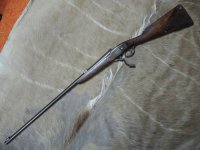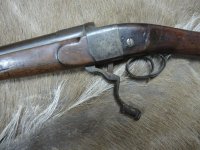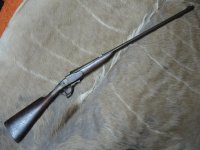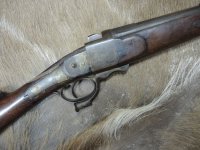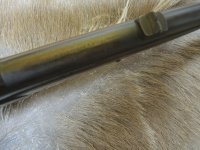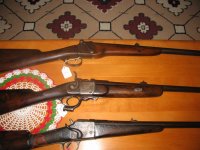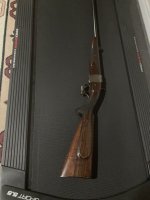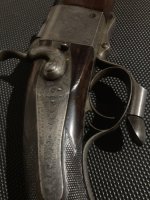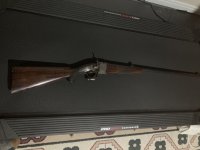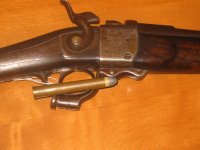You are using an out of date browser. It may not display this or other websites correctly.
You should upgrade or use an alternative browser.
You should upgrade or use an alternative browser.
+++++ IDENTIFY THIS RIFLE +++++
- Thread starter weimajack
- Start date
Looks to be an Alex Henry patent rifle. Probably .450 back powder express. The name on the barrel is probably the retailer, not the maker.
Needs some thoughtful TLC.
Finding an appropriate replacement hammer might take a bit of a search.
Needs some thoughtful TLC.
Finding an appropriate replacement hammer might take a bit of a search.
Good chance it was a sealing rifle but i don't see any name marked in the stock, the first picture are of a Alex Henry C grade and the last picture are of some sealing rifles and a close up of the Alex Henry seal rifle hamer
Attachments
i was curious so did some digging, a snippet I foundslightly off topic, but I have always been puzzled why sealing rifles seem to be such heavy cartridges. I find myself wondering if the seals were being shot at a relatively long range
cheers mooncoon
“The effectual and instant killing of seals on ice is an illustration; failing to kill a seal dead, he will, to a certainty, reach his hole in the ice, and disappear,
to the shooters serious disappointment. Small bore elongated bullets were very rapidly adopted, and as rapidly abandoned. The did not kill dead; the spherical
ball did this better. It would be wise to pause and consider whether a good military rifle is a good game-shooting rifle or not; whether the hole in the beast be
wide enough, I am inclined to think the reduction to a bore of 25 (.577"), too small for this purpose."
The seal needs to be killed right there, dead on the ice. Otherwise it is down the hole and lost.
Nowadays, for hunting seals on the ice, think in terms of a varmint rifle and a head shot.
One chap I knew kept his dogs fed using a .25-06. But most any flat shooting, high velocity rifle works well.
Nowadays, for hunting seals on the ice, think in terms of a varmint rifle and a head shot.
One chap I knew kept his dogs fed using a .25-06. But most any flat shooting, high velocity rifle works well.
Looks like an Alex Henry sealing rifle in .450. You can read about it here:
https://www.vintageguns.co.uk/magazine/the-alex-henry-sealing-rifle
Scholefield was indeed the retailer, but there is more to the name than just that; there is a long history and association with important names in the business. Taken from what I've written elsewhere, it started with Clement Cotterill. He was a merchant at No. 1, Old Square, Birmingham. He started in business as a leather seller in Edgbaston St., and by 1780 he was established as a hardware merchant and manufacturer. He founded the firm of Cotterill & Francis, a partnership that lasted ten years. In 1795 Cotterill entered into another partnership with Thomas Ketland of Philadelphia, “for the collection of hardwares, buttons, buckles, and all other articles manufactured in this and the neighbouring towns, and exported to the United States of North America and elsewhere.” Cotterill’s sons William and Thomas joined the business, first trading as Ketland, Cotterill, & Son (until 1802), then as Clement Cotterill & Sons (until 1806). In 1825, following his daughter Mary’s marriage to Joshua Scholefield, the Member of Parliament for Birmingham, the firm traded as Scholefield & Sons.
At an unknown date, John Dent Goodman became a partner in the business, and in 1861-1862 Scholefield Sons & Goodman operated from Liverpool. In Birmingham, the firm of Scholefield, Goodman and Son, merchants, worked from 5 Minories, and in 1877-1878 the business moved to 135 Edmund street. At some point, the firm expanded to 31, Great St. Helens, London. The original Scholefield business may have traded in guns as part of their hardware business, but the involvement of Goodman firmly linked the company to the gun trade. Goodman was the Chairman of the Birmingham Small-Arms Trade Association, formed in 1854 by Goodman, John Field Swinburn, Isaac Hollis, Thomas Turner, Joseph Bourne, Thomas Wilson, John Rock Cooper, William Tranter, Charles Playfair, Benjamin and Henry Woodward, and others.
In 1861 the association members decided to establish the Birmingham Small Arms and Metal Company Ltd. (B.S.A.) to produce arms by machinery and thereby compete with the government operations at Enfield. Goodman was elected Chairman of the Board of B.S.A. in 1863, a position he held until 1900. Goodman was personally involved in all the trade contracts with the U.S. government over provisions of arms in the period of the American Civil War. Scholefield, Goodman and Son was one of the companies involved in shipping Enfield-pattern guns; Goodman also secured the contract to convert 100,000 Pattern 1853 Enfield rifles using the Snider action. Goodman was also in partnership with Joseph Rock Cooper & Co. of pepperbox pistol fame.
In 1856 Goodman became Chairman of the Birmingham Proof House, then in 1867, Abingdon Works was formed, a manufacturing partnership located in Shadwell Street to supply the trade with ready-made guns and gun parts. The Abington Works partners were Goodman, Thomas Bentley, William Bourne, Charles Cooper, Charles Pryse, Richard Redman, Joseph Smith, Charles Playfair, Joseph Wilson, John Field Swinburn and Fred and Henry Woodward. But, despite Goodman’s widespread involvement in the gun trade and being a partner in several companies that made and sold guns, his name rarely appeared on them.
Scholefield, Goodman & Sons supplied Scholefield-marked rifles to the Newfoundland sealing trade, many of which were single-shot Field’s Patent side-lever in .450 calibre. Goodman visited Newfoundland several times, perhaps seeking new business opportunities.
I hope this adds a bit of information to your rifle, and its history.
https://www.vintageguns.co.uk/magazine/the-alex-henry-sealing-rifle
Scholefield was indeed the retailer, but there is more to the name than just that; there is a long history and association with important names in the business. Taken from what I've written elsewhere, it started with Clement Cotterill. He was a merchant at No. 1, Old Square, Birmingham. He started in business as a leather seller in Edgbaston St., and by 1780 he was established as a hardware merchant and manufacturer. He founded the firm of Cotterill & Francis, a partnership that lasted ten years. In 1795 Cotterill entered into another partnership with Thomas Ketland of Philadelphia, “for the collection of hardwares, buttons, buckles, and all other articles manufactured in this and the neighbouring towns, and exported to the United States of North America and elsewhere.” Cotterill’s sons William and Thomas joined the business, first trading as Ketland, Cotterill, & Son (until 1802), then as Clement Cotterill & Sons (until 1806). In 1825, following his daughter Mary’s marriage to Joshua Scholefield, the Member of Parliament for Birmingham, the firm traded as Scholefield & Sons.
At an unknown date, John Dent Goodman became a partner in the business, and in 1861-1862 Scholefield Sons & Goodman operated from Liverpool. In Birmingham, the firm of Scholefield, Goodman and Son, merchants, worked from 5 Minories, and in 1877-1878 the business moved to 135 Edmund street. At some point, the firm expanded to 31, Great St. Helens, London. The original Scholefield business may have traded in guns as part of their hardware business, but the involvement of Goodman firmly linked the company to the gun trade. Goodman was the Chairman of the Birmingham Small-Arms Trade Association, formed in 1854 by Goodman, John Field Swinburn, Isaac Hollis, Thomas Turner, Joseph Bourne, Thomas Wilson, John Rock Cooper, William Tranter, Charles Playfair, Benjamin and Henry Woodward, and others.
In 1861 the association members decided to establish the Birmingham Small Arms and Metal Company Ltd. (B.S.A.) to produce arms by machinery and thereby compete with the government operations at Enfield. Goodman was elected Chairman of the Board of B.S.A. in 1863, a position he held until 1900. Goodman was personally involved in all the trade contracts with the U.S. government over provisions of arms in the period of the American Civil War. Scholefield, Goodman and Son was one of the companies involved in shipping Enfield-pattern guns; Goodman also secured the contract to convert 100,000 Pattern 1853 Enfield rifles using the Snider action. Goodman was also in partnership with Joseph Rock Cooper & Co. of pepperbox pistol fame.
In 1856 Goodman became Chairman of the Birmingham Proof House, then in 1867, Abingdon Works was formed, a manufacturing partnership located in Shadwell Street to supply the trade with ready-made guns and gun parts. The Abington Works partners were Goodman, Thomas Bentley, William Bourne, Charles Cooper, Charles Pryse, Richard Redman, Joseph Smith, Charles Playfair, Joseph Wilson, John Field Swinburn and Fred and Henry Woodward. But, despite Goodman’s widespread involvement in the gun trade and being a partner in several companies that made and sold guns, his name rarely appeared on them.
Scholefield, Goodman & Sons supplied Scholefield-marked rifles to the Newfoundland sealing trade, many of which were single-shot Field’s Patent side-lever in .450 calibre. Goodman visited Newfoundland several times, perhaps seeking new business opportunities.
I hope this adds a bit of information to your rifle, and its history.
I have examples of 3 different actions in 450 express for sealing here in NL. The Field patent one that pinfire mentioned, two Alex henry style actions and a Farquharson action named to the SS Nascopie. All very cool pieces of history. If you wanted some dimensions for a hammer I can take them off of my two examples















































